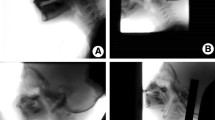Abstract
Background
There are minimal data on radiation doses to infants and children undergoing a modified barium swallow (MBS) study.
Objective
To document screening times, dose area product (DAP) and effective doses to children undergoing MBS and to determine factors associated with increased screening times and effective dose.
Materials and methods
Fluoroscopic data (screening time, DAP, kVp) for 90 consecutive MBS studies using pulse fluoroscopy were prospectively recorded; effective dose was calculated and data were analyzed for effects of behavior, number of swallow presentations, swallowing dysfunction and medical problems.
Results
Mean effective dose for the entire group was 0.0826 ± 0.0544 mSv, screening time 2.48 ± 0.81 min, and DAP 28.79 ± 41.72 cGy cm2. Significant differences were found across three age groups (≤1.0, >1.0–3.0 and >3.0 years) for effective dose (mean 0.1188, 0.0651 and 0.0529 mSv, respectively; P < 0.001), but not for screening time or DAP. Effective dose was correlated with screening time (P = 0.007), DAP (P < 0.001), number of swallow presentations (P = 0.007), lower age (P = 0.017), female gender (P = 0.004), and height (P < 0.001). Screening time was correlated with total number of swallow presentations (P < 0.001) and DAP (P < 0.001).
Conclusion
Screening times, DAP, effective dose, and child and procedural factors associated with higher effective doses are presented for children undergoing MBS studies.
Similar content being viewed by others
References
Benson JE, Lefton-Greif MA (1994) Videofluoroscopy of swallowing in pediatric patients: a component of the total feeding evaluation. In: Tuchman DN, Walter RS (eds) Disorders of feeding and swallowing in infants and children. Singular, San Diego, pp 187–200
Brenner DJ (2002) Estimating cancer risks from pediatric CT: going from the qualitative to the quantitative. Pediatr Radiol 32:228–233
Pierce DA, Shimizu Y, Preston DL et al (1996) Studies of the mortality of atomic bomb survivors. Report 12, Part I. Cancer: 1950–1990. Radiat Res 146:1–27
Seibert JA (2004) Tradeoffs between image quality and dose. Pediatr Radiol 34 [Suppl 3]:183–195
Suleiman OH (2004) Radiation doses in pediatric radiology: influence of regulations and standards. Pediatr Radiol 34 [Suppl 3]:242–246
Willis CE, Slovis TL (2004) The ALARA concept in pediatric CR and DR: dose reduction in pediatric radiographic exams – a white paper conference executive summary. Pediatr Radiol 34(Suppl 3):162–164
Australian Radiation Protection and Nuclear Safety Agency (2002) Radiation protection series, 1. Recommendations for limiting exposure to ionizing radiation (1995), guidance note NOHSC:3022(1995). National standard for limiting occupational exposure to ionizing radiation, NOHSC:1013(1995). National Occupational Health and Safety Commission. ARPANSA, Yallambie, Victoria
Tolbert D (1996) Sources of radiation exposure. In: Jandower M, Linton O (eds) Radiation risk: a primer. American College of Radiology, Reston, pp 3–4
Willis CE (2004) Strategies for dose reduction in ordinary radiographic examinations using CR and DR. Pediatr Radiol 34 [Suppl 3]:196–200
Arvedson JC, Lefton-Greif MA (1998) Pediatric videofluoroscopic swallow studies: a professional manual with care-giver guidelines. Communication Skill Builders/Psychological Corporation, San Antonio
Huda W (2002) Effective doses to adult and pediatric patients. Pediatr Radiol 32:272–279
Logemann JA (1993) Manual for the videofluorographic study of swallowing, 2nd edn. Pro-Ed, Austin
Lefton-Greif MA, Crawford TO, Winkelstein JA et al (2000) Oropharyngeal dysphagia and aspiration in patients with ataxia-telangiectasia. J Pediatr 136:225–231
Newman LA, Cleveland RH, Blickman JG et al (1991) Videofluoroscopic analysis of the infant swallow. Invest Radiol 26:870–873
Griggs CA, Jones PM, Lee RE (1989) Videofluoroscopic investigation of feeding disorders of children with multiple handicap. Dev Med Child Neurol 31:303–308
Jolley SG, McClelland KK, Mosesso-Rousseau M (1995) Pharyngeal and swallowing disorders in infants. Semin Pediatr Surg 4:157–165
Wright RE, Boyd CS, Workman A (1998) Radiation doses to patients during pharyngeal videofluoroscopy. Dysphagia 13:113–115
Baikie G, South MJ, Reddihough DS et al (2005) Agreement of aspiration tests using barium videofluoroscopy, salivagram, and milk scan in children with cerebral palsy. Dev Med Child Neurol 47:86–93
Lee WS, Beattie RM, Meadows N et al (1999) Gastro-oesophageal reflux: clinical profiles and outcome. J Paediatr Child Health 35:568–571
Field D, Garland M, Williams K (2003) Correlates of specific childhood feeding problems. J Paediatr Child Health 39:299–304
Tapiovaara M, Lakkisto M, Servomaa A (1997) PCXMC – a PC-based Monte Carlo program for calculating patient doses in medical x-ray examinations. Finnish Centre for Radiation and Nuclear Safety (STUK), Helsinki, pp 1–46
Damilakis J, Stratakis J, Raissaki M et al (2006) Normalized dose data for upper gastrointestinal tract contrast studies performed to infants. Med Phys 33:1033–1040
Khursheed A, Hillier MC, Shrimpton PC et al (2002) Influence of patient age on normalized effective doses calculated for CT examinations. Br J Radiol 75:819–830
McLean D, Malitz N, Lewis S (2003) Survey of effective dose levels from typical paediatric CT protocols. Australas Radiol 47:135–142
Chapple C-L, Willis S, Frame J (2002) Effective dose in paediatric computed tomography. Phys Med Biol 47:107–115
O’Donoghue S, Bagnall A (1999) Videofluoroscopic evaluation in the assessment of swallowing disorders in paediatric and adult populations. Folia Phoniatr Logop 51:159–171
Author information
Authors and Affiliations
Corresponding author
Additional information
This work was supported by the Royal Children’s Hospital Foundation, Brisbane.
Rights and permissions
About this article
Cite this article
Weir, K.A., McMahon, S.M., Long, G. et al. Radiation doses to children during modified barium swallow studies. Pediatr Radiol 37, 283–290 (2007). https://doi.org/10.1007/s00247-006-0397-6
Received:
Revised:
Accepted:
Published:
Issue Date:
DOI: https://doi.org/10.1007/s00247-006-0397-6




